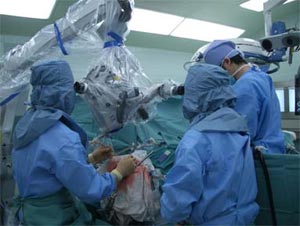 |
|
|
| Introduction |
|---|
|
Prof. emeritus Shozo Ishii (current supreme advisor of Juntendo University) established our department in 1968 as one of the most historical neurosurgical branch in Japan. Prof. emeritus Kiyoshi Sato (current director of Juntendo Tokyo Koto Geriatric Medical Center) succeeded his policy, and then Prof. Hajime Arai has developed to the modern neurosurgery since 2002. We carry out more than 450 surgeries annually, covered all fields of neurosurgery. Our department has developed strong commitment to update our knowledge on surgical treatment, emergency care, neurology, peri-surgical management, imaging diagnosis, and basic researches, for providing contemporary education and fostering specialists in neurosurgery.
|
| ��Top |
| Education Philosophy |
|---|
| We think that students and residents who study on neurosurgery need not only a principal knowledge of neuronal diseases but also a specialized emergency care. We teach them all aspects of emergency care to make an appropriate decision. Unfortunately, neurosurgery is not included in the postgraduate clinical training programs in our university, therefore we let the students experienced the practical scene as many as possible through the bedside learning, and kept and lifted up their motivations for mastering neurosurgery after graduation. |
| ��Top |
| Sub-specialty and Clinical Training |
|---|
| 1. | Brain tumors |
| Our department performs surgical treatments of a wide variety of brain tumors including glioma, meningioma, acoustic neurinoma, and pituitary adenoma. Students learn the neuro-oncology, surgical anatomy, and surgical procedure at the operating room. An attending doctor explains the surgical procedure in detail. Radiation therapy and chemo-therapy are required for some kind of brain tumors, especially glioma, germinoma, and malignant lymphoma. The students also learn the scientific background and processes of these therapies. | 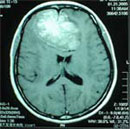 |
 |
| 2. | Cerebrovascular Disease |
| This category includes core diseases treating at neurosurgery, such as subarachnoid hemorrhage, intracerebral hemorrhage, and cerebral infarction. In an emergency situation for cerebrovascular disease, the students learn the practical care from emergency room to operating room. Recently, intravascular surgery has been widely performed for the vascular disease. The students have an opportunity to learn the principal intravascular interventions for aneurismal coiling, carotid artery stenting, and embolization for arteriovenous malformation. |
| 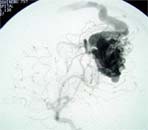 | 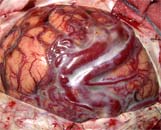 |
|  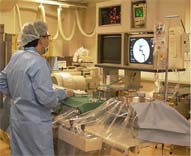 |
 |
| 3. | Head Injury |
| This category includes some traumas that need emergency surgery such as acute epidural hematoma, acute subdural hematoma, and chronic subdural hematoma. The students practically learn actual surgery and peri-surgical intensive care as well as processes for diagnosis. | 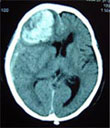 |
|
��Top |
 |
| 4. | Emergency Medical Care |
| �@Some patients transported to our emergency room should be treated as quickly as possible. The students have an opportunity to learn the actual cases that need urgent treatment based on prompt diagnosis with the supervision of an attending doctor. |
 |
| 5. | Pediatric Neurosurgery |
| Our department is one of the few university hospitals that own a department specialized in pediatric neurosurgery. We treat patients with hydrocephalus, myelomeningocele, and other various kinds of anomalies in the central nervous system. The students learn not only the pediatric neurosurgery but also peri-surgical management that differs the adult cases. You have a valuable opportunity to experience the pediatric care, and we convince that your experience here help your understanding. |
| 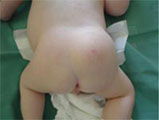 |
| 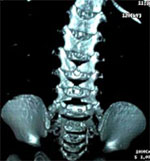 |
 |
| 6. | Functional Neurosurgery |
| Epilepsy, Parkinson disease (Deep Brain Stimulation), hemifacial spasm, and trigeminal neuralgia are included in this category. Logical therapeutic strategies are required for these kinds of diseases before surgery. The students also learn the process to the diagnosis. | 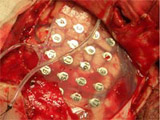 |
 |
| 7. | Spinal Surgery |
| �@Recently, neurosurgeon treats spondylosis, disc herniation, and spinal tumors even in Japan. Our department also treats them. You need understanding on neurology and spinal dynamics. Furthermore, some knowledge of spinal cord injury determines the success in treatment at the scene of an emergency. | 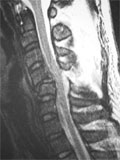 | | 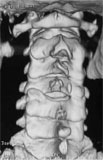 |
| ��Top |
| Clinical Training Program |
|---|
Our training program for students is based on the actual scene at operating room. Treatment at the emergency room and ICU (intensive care unit) is also major practice of our program.
Our professor (Chairman), associate and assistant professors teach the principals of neurosurgery concisely at a small group discussion.
In the elective course for sixth-grade students, the students participate in patient management and support surgeons at the operating room to learn a specialized knowledge on surgical treatment.
|
| ��Top |
|

